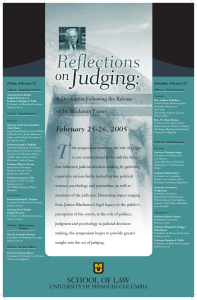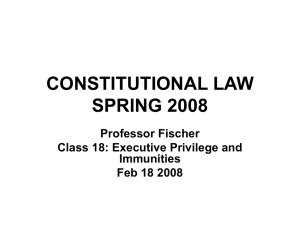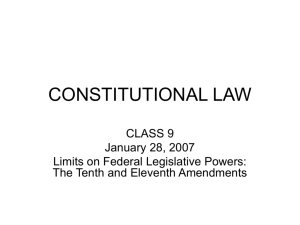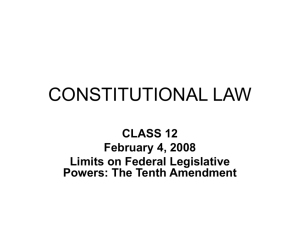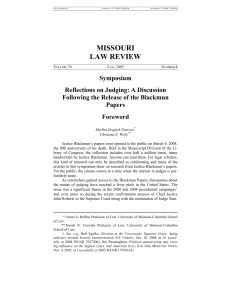Lifting the Veil: Justice Blackmun’s Papers Court
advertisement
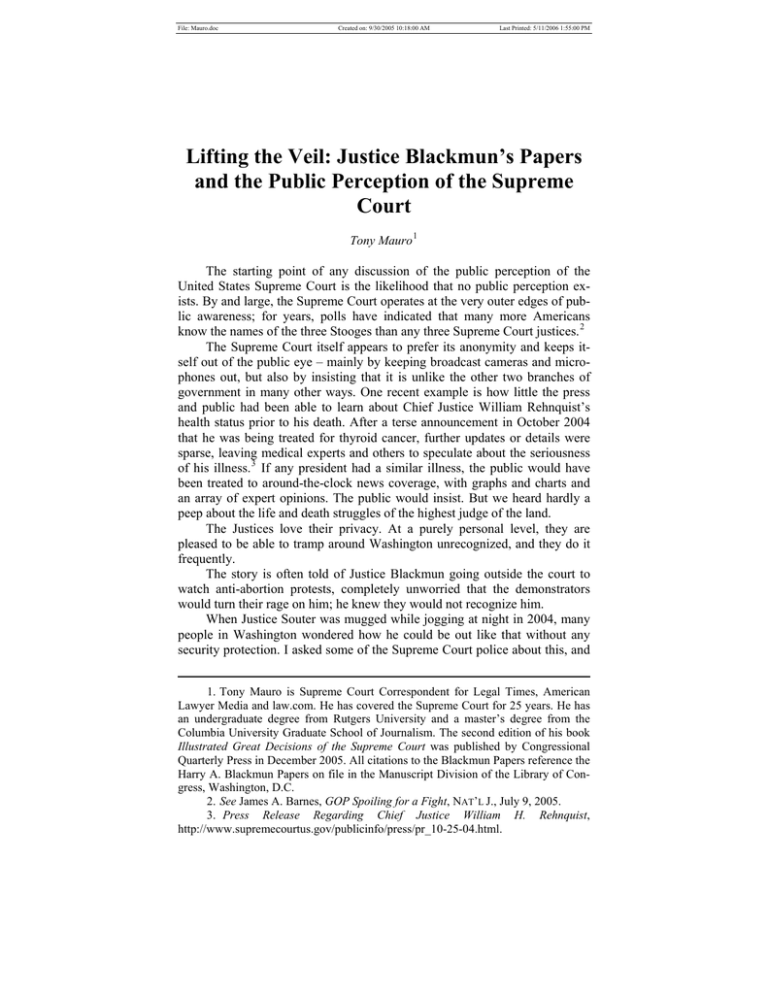
File: Mauro.doc Created on: 9/30/2005 10:18:00 AM Last Printed: 5/11/2006 1:55:00 PM Lifting the Veil: Justice Blackmun’s Papers and the Public Perception of the Supreme Court Tony Mauro 1 The starting point of any discussion of the public perception of the United States Supreme Court is the likelihood that no public perception exists. By and large, the Supreme Court operates at the very outer edges of public awareness; for years, polls have indicated that many more Americans know the names of the three Stooges than any three Supreme Court justices. 2 The Supreme Court itself appears to prefer its anonymity and keeps itself out of the public eye – mainly by keeping broadcast cameras and microphones out, but also by insisting that it is unlike the other two branches of government in many other ways. One recent example is how little the press and public had been able to learn about Chief Justice William Rehnquist’s health status prior to his death. After a terse announcement in October 2004 that he was being treated for thyroid cancer, further updates or details were sparse, leaving medical experts and others to speculate about the seriousness of his illness. 3 If any president had a similar illness, the public would have been treated to around-the-clock news coverage, with graphs and charts and an array of expert opinions. The public would insist. But we heard hardly a peep about the life and death struggles of the highest judge of the land. The Justices love their privacy. At a purely personal level, they are pleased to be able to tramp around Washington unrecognized, and they do it frequently. The story is often told of Justice Blackmun going outside the court to watch anti-abortion protests, completely unworried that the demonstrators would turn their rage on him; he knew they would not recognize him. When Justice Souter was mugged while jogging at night in 2004, many people in Washington wondered how he could be out like that without any security protection. I asked some of the Supreme Court police about this, and 1. Tony Mauro is Supreme Court Correspondent for Legal Times, American Lawyer Media and law.com. He has covered the Supreme Court for 25 years. He has an undergraduate degree from Rutgers University and a master’s degree from the Columbia University Graduate School of Journalism. The second edition of his book Illustrated Great Decisions of the Supreme Court was published by Congressional Quarterly Press in December 2005. All citations to the Blackmun Papers reference the Harry A. Blackmun Papers on file in the Manuscript Division of the Library of Congress, Washington, D.C. 2. See James A. Barnes, GOP Spoiling for a Fight, NAT’L J., July 9, 2005. 3. Press Release Regarding Chief Justice William H. Rehnquist, http://www.supremecourtus.gov/publicinfo/press/pr_10-25-04.html. File: Mauro.doc 1038 Created on: 9/30/2005 10:18:00 AM MISSOURI LAW REVIEW Last Printed: 5/11/2006 1:55:00 PM [Vol. 70 they said they try to urge more security on the Justices, but the Justices do not want it. Their first line of defense is their anonymity, the police officers said. 4 Chief Justice Rehnquist was once asked if he liked his job, and he replied that it was the perfect job for him, because he could do important work without losing his personal privacy. 5 One of the things he did not like about presiding over President Clinton’s impeachment was the loss of privacy for that period. The Chief Justice even found camera crews camped outside his front door. But soon, anonymity returned. (The cameras came back again in June 2005, however, when camera crews tracked his comings and goings in anticipation of his expected retirement. After weeks of the spectacle, Rehnquist announced he had no plans to retire, and the cameras went away.) The Court and some commentators also justify the Court’s love for anonymity as serving higher goals, not just creature comfort. Justice Scalia has argued often that common law judges are not supposed to be high-profile personages and should not be perceived as part of the daily rough and tumble of politics and media attention. 6 Political scientist Barbara Perry has even argued that part of the Supreme Court’s moral authority, its power of persuasion, lies in its invisibility. Not too long ago she wrote, “[I]ts success in maintaining respect is almost magical. To spoil the magic by exposing it to excess ‘daylight’ might rob the nation and indeed the world of a stable and enduring emblem of the rule of law.” 7 To some extent, Perry has a point, though if you think about it, her assertion implies that she believes the old adage, “familiarity breeds contempt.” In other words, she almost seems to be suggesting that if we saw more of the Supreme Court, we would not like what we see. The notion that a democratic institution depends on invisibility for its authority and popularity is troubling and is something even the CIA might not assert anymore. Yet it is true that for whatever reason, the Supreme Court does occupy a special place in the public’s esteem, whenever the public thinks about it. The fact that the court has survived and thrived past the controversy over Bush v. Gore 8 in 2000 is a tribute to its durability as a trusted, if not loved, branch of government. Against that backdrop, we can begin to assess the impact on the Supreme Court and on the public when, in March of 2004, we began reading and hearing accounts of the contents of the more than a half-million docu4. Tony Mauro, Court Revisits Security After Souter Assault; The question of whether justices need more protection is once again confronting officials at the Supreme Court, LEGAL TIMES, May 10, 2004, at 11. 5. Tony Mauro, The Young “Radical” who Grew into a Leader, LEGAL TIMES, Sept. 12, 2005, at 14. 6. Antonin Scalia, The Francis Boyer Lecture at the AEI Policy Conference, FED. NEWS SERVICE, Dec. 6, 1989. 7. BARBARA A. PERRY, THE PRIESTLY TRIBE: THE SUPREME COURT’S IMAGE IN THE AMERICAN MIND 155 (1999). 8. 531 U.S. 98 (2000). File: Mauro.doc 2005] Created on: 9/30/2005 10:18:00 AM LIFTING THE VEIL Last Printed: 5/11/2006 1:55:00 PM 1039 ments contained in the Harry Blackmun Papers at the Library of Congress. As he had directed, Justice Blackmun’s papers were released on the fifth anniversary of his death. The Justices, it is safe to surmise, were not pleased. At various times both publicly and privately, several Justices have said they think Justices’ papers should remain private longer than they did in Justice Blackmun’s case – 10 years after death, for example, or, as some have urged, after the retirement or death of every Justice with whom he or she served. Under that rule, if we are to believe Justice Thomas’s threat to double his age on the court, then we would not see any current Justice’s papers until the year 2036. As it happened, because of the coincidence of when Justice Blackmun died in relation to when he retired, the release came roughly 10 years after he left the court – which means the case files are no newer than 10 years old, though he retained many important documents, unrelated to Supreme Court cases, well into his retirement. His file contained, for example, a copy of the 1998 recodification of the law clerks’ code of conduct – an invaluable document for anyone assessing the role of law clerks in today’s Court. 9 The Court’s anger about the release of the Blackmun Papers, however, seemed to be of a much lesser magnitude than its reaction after the release of the Thurgood Marshall Papers 11 years earlier. Marshall retired in October of 1991 and died in January 1993, and he had ordered his papers released immediately upon his death. As a result, some of the case files exposed to daylight were less than two years old – too fresh for many of the Justices to find tolerable. The Court voiced its displeasure at the Library of Congress, suggesting it had somehow conned Justice Marshall into allowing the early release. But many others think it is highly unlikely that anyone misled Justice Marshall. What may have happened is that he simply died much earlier than he had planned, and his papers became public a lot earlier than he could have imagined. 10 There was another difference in how the Blackmun Papers were released as opposed to the Marshall Papers. Whereas the Marshall Papers touched off a media free-for-all, there was a much more controlled media environment surrounding the release of the Blackmun Papers. To the surprise of many in the news media and academia, both the New York Times and National Public Radio were given advance access to the Blackmun Papers – about three months – before the rest of the media were allowed to look at them at the Library of Congress. 11 Justice Blackmun’s daughter Sally and Yale Law School dean Harold Koh, believed they were carrying out Justice Blackmun’s wishes by granting this access, and there is 9. Code of Conduct for Law Clerks of the Supreme Court of the United States (Blackmun Papers, Box 1568, folder 13). 10. See Tony Mauro, The Supreme Court and the Cult of Secrecy, in A YEAR IN THE LIFE OF THE SUPREME COURT (Rodney A. Smolla ed., 1995). 11. Tony Mauro, Anticipation Building for Release of Blackmun Papers, LEGAL TIMES, Jan. 26, 2004, at 1. File: Mauro.doc 1040 Created on: 9/30/2005 10:18:00 AM MISSOURI LAW REVIEW Last Printed: 5/11/2006 1:55:00 PM [Vol. 70 no reason to disbelieve them. Because of the untidy aftermath of the release of the Marshall Papers, they wanted a more orderly – and more thoughtful – process when the Blackmun Papers were released. By and large, it appears that these goals were accomplished. A lot of bruised egos and sour grapes simmered among the reporters who covered the Supreme Court, as well as among scholars who do research about the Court. And if pressed, it would be possible to articulate a reason why playing media favorites with a collection of such obvious public importance was improper. But I found myself suffering from a deficit of outrage; it was clearly up to the Blackmun family to decide how the release should take place, and there was little that anyone else could do about it. These are not like presidential papers by any means, at least in terms of their legal status. Blackmun could have chosen not to release them at all – or he could have had them burned, as Hugo Black apparently did with many of his papers. But the exclusive release to the Times and to NPR had one probably unintended consequence. It may have served to reduce the amount of coverage the Blackmun Papers got from other media organizations. It is simply a matter of human nature, as well as the competitiveness of the media, that if one news organization has the corner on a story, other news organizations are less likely to invest heavily in covering the same story; some might even find it in their interest to knock down the story or minimize its importance. I for one think the Blackmun Papers were a bounteous gift to the news media and to the public that will keep on giving for years to come. But what is the story line of the Blackmun Papers thus far? As with the Marshall Papers, I think the Blackmun Papers reveal a Supreme Court that is extremely conscientious and dedicated to reaching the right answer. They discuss, they research, they agonize; they even change their minds, as became evident with Justice Kennedy in both Planned Parenthood of Southeast Pennsylvania v. Casey 12 and Lee v. Weisman. 13 Of course, Justice Kennedy’s vote switch had been reported before by Professor Reuben and others, 14 but to see hard evidence in Justice Blackmun’s papers tells us in pretty stark terms how close the nation came to having Roe v. Wade overturned. But just as important, in my view, is that Justice Blackmun’s papers reveal that the demigods we call Supreme Court Justices are indeed human. They pass notes to each other on the bench, though they were probably unaware that Justice Blackmun would keep every one of them – including a 12. See LINDA GREENHOUSE, BECOMING JUSTICE BLACKMUN: HARRY BLACKMUN’S SUPREME COURT JOURNEY 203-04 (2005); Planned Parenthood of Se. Pa. v. Casey, 505 U.S. 833 (1992). 13. See Memorandum from Anthony M. Kennedy to Harry A. Blackmun (March 30, 1992) (Blackmun Papers, Box 586, folder 6); Lee v. Weisman, 505 U.S. 577 (1992). 14. Richard C. Reuben, Man in the Middle, CAL. LAWYER, Oct. 1992, at 35-38, 103. File: Mauro.doc 2005] Created on: 9/30/2005 10:18:00 AM LIFTING THE VEIL Last Printed: 5/11/2006 1:55:00 PM 1041 bawdy limerick offered by then-associate Justice Rehnquist to his all-male colleagues, probably during a particularly boring oral argument. 15 In that same file was a note from Justice O’Connor in which she said, “Harry, the Court took the wrong turn today in the Free Exercise case in my view. It pains me.” 16 The note was dated April 17, 1990, the day the Court handed down Employment Division v. Smith, which said Oregon could punish members of a Native American church who used peyote in religious rituals. 17 In one of the early scholarly writings based on the Papers, we even learned that the Justices ran an office pool to predict the outcome of the 1992 presidential election. As professors Forrest Maltzman, Lee Sigelman and Paul Wahlbeck concluded in their tongue-in-cheek article, “Mr. Dooley was literally correct: the Supreme Court does follow the election returns.” 18 Incidentally, among the six Justices who participated in the pool, Justice O’Connor won the most – a grand total of $18.30. 19 In almost every box of the Papers, there are poignant or at least interesting human stories. One such story turned up in Justice Blackmun’s file on Justice David Souter. 20 It involved one of Justice Blackmun’s daily rituals. As many people know, he had breakfast at the Supreme Court public cafeteria regularly, joined by a shifting cast of current and former law clerks and friends. But because he was in such a public setting, others who recognized him would sometimes approach him, to the occasional dismay of Court police and Justice Blackmun himself. Justice Blackmun’s file contains the story of one such approach that went awry in March 1997, nearly three years after he retired. Justice Blackmun still came to the Court quite often. Justice Souter wrote Justice Blackmun to apprise him of the episode, which involved someone who was at the Court to attend an oral argument as Souter’s guest. 21 That guest was Raafat Toss, then an aide to American Civil Liberties Union President Nadine Strossen. 22 As Mr. Toss recounted it in a letter to Souter that was in Blackmun’s file, Mr. Toss had spotted Justice Blackmun in the cafeteria that morning. 23 After seeing two other people approach and greet the retired 15. Memorandum from William H. Rehnquist (Mar. 26, 1975) (Blackmun Papers, Box 116, folder 2). 16. Sandra Day O’Connor to Harry A. Blackmun (Apr. 17, 1990) (Blackmun Papers, Box 116, folder 4). 17. Employment Div. v. Smith, 494 U.S. 872 (1990). 18. Forrest Maltzman, Lee Sigelman, & Paul J. Wahlbeck, Supreme Court Justices Really Do Follow the Election Returns, PSOnline Oct. 2004, at 839, available at http://www.apsanet.org. 19. Id. 20. See File regarding David H. Souter (Blackmun Papers, Box 1408, folder 8). 21. David H. Souter to Harry A. Blackmun (Mar. 28, 1997) (Blackmun Papers, Box 1408, folder 8). 22. Id. 23. Raafat S. Toss to David H. Souter (Mar. 4, 1997) (Blackmun Papers, Box 1408, folder 8). File: Mauro.doc 1042 Created on: 9/30/2005 10:18:00 AM MISSOURI LAW REVIEW Last Printed: 5/11/2006 1:55:00 PM [Vol. 70 Justice, Mr. Toss decided to do the same. His letter went on to say, “As I said, ‘Mr. Justice’ and his hand met mine, three Supreme Court officers descended on me; one of them physically held me back.” 24 Another officer told Toss, “Stop bothering the justice. Can’t you see he’s having breakfast?” 25 Toss said he mumbled something, and an officer leaned over and whispered, “We won’t arrest you if you sit down.” 26 Toss wrote, “Given that smorgasbord of choices, I opted to sit down.” 27 But soon Toss, who is of Egyptian heritage, said he saw someone else approach Blackmun, and that person, like the earlier two, was not impeded by police. 28 “I couldn’t see the difference between me and the three others,” Toss continued. 29 Well, not until I looked in a mirror. See, the difference is that all those who approached Justice Blackmun were white men. I suppose I fit someone’s profile of a Mediterranean meany -- an extremist of some sort. I should have left my face at home. Mr. Justice Souter, while great minds might argue about keeping cameras out of the courtroom, I think we can all agree to keep profiling out of the cafeteria. 30 In conveying the note to Justice Blackmun, Justice Souter said Toss’s description of the incident was “pretty awful,” and he intended to “take the matter up (in as low a key as possible) with the Marshal of the Court.” 31 But first, Justice Souter wanted to know how Justice Blackmun recalled the episode. 32 Justice Blackmun replied in writing that “I have no recollection of the incident,” but he encouraged Justice Souter to pursue his inquiry with the Marshal and named the clerks in his own chambers who might be able to shed light on it. 33 Two of those clerks wrote to Justice Souter, confirming Toss’ account. One of the clerks wrote, “I think all of us, including Justice Blackmun, felt badly about the way the officers treated him. On the other hand, we 24. Id. 25. Id. 26. Id. 27. Id. 28. Id. 29. Id. 30. Id. 31. David H. Souter to Harry A. Blackmun (Mar. 28, 1997) (Blackmun Papers, Box 1408, folder 8). 32. Id. 33. Harry A. Blackmun to David H. Souter (Apr. 4, 1997) (Blackmun Papers, Box 1408, folder 8). File: Mauro.doc 2005] Created on: 9/30/2005 10:18:00 AM LIFTING THE VEIL Last Printed: 5/11/2006 1:55:00 PM 1043 understood that the officers’ intent was to protect the Justice.” 34 No further correspondence appears in the file, and it is unclear what, if anything, came of Justice Souter’s inquiry. Why tell this story? And what does it reveal about the Supreme Court? I think it is priceless, and to my mind, as important as the case files and conference notes that give us a blow-by-blow report of how a decision took shape. This anecdote reveals a lot about Justice Blackmun, about Justice Souter, and about the internal life of the Court. I also came across a fascinating exchange of letters indicating that soon after she joined the court, Justice Ginsburg spent a good amount of time, not looking at the cases before her, but trying to redesign the certificates of admission for new members of the Supreme Court bar. 35 The certificates had always used the traditional words “in the year of our Lord,” to identify the date they were issued, a phrase which, it turns out, is offensive to a certain number of applicants every year, on religious grounds. 36 Justice Ginsburg surveyed the wording for certificates of all the federal circuits, and with the approval of her colleagues, the court now offers two certificates – one with and one without those words. 37 Characteristically, Justice Blackmun took notes on the discussion about her proposal, and in his handwriting the following words appear: “We protest too much.” 38 It is not clear whether those are his words or those of another Justice. But again, I would submit, this exchange opens a fascinating window into how the Court adapts and changes, and how a single new Justice can bring a new perspective on a traditional practice that most likely had gone unexamined for decades, if ever. What else have we learned? That Justice Blackmun assisted Scott Armstrong in his research for the controversial book The Brethren. 39 The book, published in 1979, leaves its sources unnamed, and the speculation ever since has centered on Potter Stewart as the main source. The Blackmun Papers make it clear that he talked to Armstrong and gave permission for several of his former law clerks to do the same. We have also gotten a glimpse at the public pressure that is exerted on Supreme Court Justices – and how they respond. The many folders devoted to mail he got about Roe v. Wade – and I doubt that he kept them all – certainly show this. 40 And the melancholy way in which he described this pressure in 34. Cecillia Wang to David H. Souter (May 20, 1997) (Blackmun Papers, Box 1408, folder 8). 35. See Blackmun Papers, Box 1420, folder 12. 36. See Ruth Bader Ginsburg to William H. Rehnquist (Nov. 30, 1993) (Blackmun Papers, Box 1420, folder 12). 37. Id. 38. Undated notes by Justice Blackmun (Blackmun Papers, Box 1420, folder 12). 39. See Memorandum from “sbj” to Harry A. Blackmun, (Blackmun Papers, Box 1435, folder 8); BOB WOODWARD & SCOTT ARMSTRONG, THE BRETHREN: INSIDE THE SUPREME COURT 121-22 (1979). 40. See Files on Roe v. Wade, (Blackmun Papers, Boxes 68-85). File: Mauro.doc 1044 Created on: 9/30/2005 10:18:00 AM MISSOURI LAW REVIEW Last Printed: 5/11/2006 1:55:00 PM [Vol. 70 his oral history interviews with Professor Koh also is very striking. “I never thought that I would be standing against the combined might of the Roman Catholic Church and the Mormon Church and 1600 Pennsylvania Avenue and other forces, with all their respected political power,” he said. 41 “It showed me once again that the federal bench is no place to win a popularity contest. . . . I suspect I’ve been called every possible epithetical name, Hitler, butcher of Dachau, Pontius Pilate, Herod, murderer, madman.” 42 I also think there are two areas in which the Blackmun Papers paint a less attractive portrait of the Court and of Justice Blackmun himself. As I looked through some of the files containing memoranda from his law clerks, I found myself somewhat surprised at how much they focused on both internal and external political considerations. There is a lot of swapping of intelligence about what other Justices are doing and thinking and much discussion of the timing of the release of opinions and whether political considerations do or should enter into the court’s considerations. In the file on Bowers v. Hardwick, 43 the 1986 Georgia sodomy case, a note from one of Blackmun’s clerks describes the majority opinion upholding the anti-sodomy law as “a disgrace” and urged the Justice not to allow it to be released on a Friday. 44 (This was the end of the term, when Fridays could be opinion days.) “A summer Friday and Saturday are probably the least likely time for people to take notice of what the Court has done. I would press, if I were you, for Monday instead.” 45 As it turned out, Bowers was released on a Monday; June 30 of 1986. In the file on the 1992 Casey abortion rights case, another Blackmun law clerk Stephanie Dangel viewed with suspicion the “troika” of Justices Kennedy, Souter and O’Connor that was writing a joint opinion upholding Roe v. Wade. This clerk wrote, “[G]iven the middle ground that they have taken, I fear the decision may have the effect of removing abortion from the political agenda just long enough to ensure the re-election of Pres. Bush and the appointment of another nominee from whom the Far Right will be sure to exact a promise to overrule Roe.” 46 Of course, the first President Bush was defeated that year, so this scenario did not come to pass. In another memo on Casey, this same clerk reported to Justice Blackmun that Justice Kennedy objected to Blackmun’s reference to Chief Justice William Rehnquist in his concurrence as “the Chief,” rather than “Chief Jus41. Fred Barbash, Blackmun’s Papers Shine Light into Court, WASH. POST, Mar. 5, 2004, at Nation A01. 42. Id. 43. Bowers v. Hardwick, 478 U.S. 186 (1986), overruled by Lawrence v. Texas, 539 U.S. 558 (2003). 44. “Pam” to Harry A. Blackmun (June 24, 1986) (Blackmun Papers, Box 451, folder 9). 45. Id. 46. “Steff” to Harry A. Blackmun (June 16, 1992) (Blackmun Papers, Box 602, folder 4). File: Mauro.doc 2005] Created on: 9/30/2005 10:18:00 AM LIFTING THE VEIL Last Printed: 5/11/2006 1:55:00 PM 1045 tice.” 47 The clerk wrote, “While I have my doubts as to whether he deserves to be called ‘Justice’ on this one, I guess there’s no need to ruffle feathers needlessly . . . .” 48 In the final version of the concurrence, Rehnquist is referred to as the Chief Justice. 49 Still another memo by this clerk referred to the fact that “evil nino” had not yet circulated his dissent in the case – referring to Justice Antonin Scalia. 50 When this clerk was asked about what she wrote back then, she said that at the time, emotions at the Court were running high. “There’s no avoiding the fact that the Court had become politicized on the issue,” she told me. 51 She apologized for the references to Rehnquist and Scalia, stressing that they were meant in jest. “I considered it part of my job to make this true American hero smile once in awhile, even if that required a few off-color characterizations of the opposition. My only regret is that these private jokes are now open to public view.” 52 Whether these cutting remarks about fellow Justices were meant to give Justice Blackmun a smile or not, they were surprising. Knowing how things work at the Court, it is safe to say that if Justice Blackmun disapproved of this kind of talk, it would not have happened – or at least it would not have been put into print in memoranda for the public to see someday. It may have been unrealistic to expect that the Supreme Court would be a gossip-free, politics-free workplace. But this aspect of Justice Blackmun’s papers warrants further exploration – especially if, as some suspect, it points toward a chambers in which law clerks had an outsized influence on their Justice. I know that some scholars are looking into this aspect of Blackmun’s service on the Court – whether, in fact, his law clerks played too large a role in Justice Blackmun’s work on the court, especially in his later years. I am sure some of the other symposium participants will address this. 53 The other somewhat unnerving aspect of Justice Blackmun’s papers can be found in the notes he took on oral argument. In many instances he graded the advocates before him – he once gave an ACLU lawyer by the name of 47. “Steff” to Harry A. Blackmun (June 26, 1992) (Blackmun Papers, Box 602, folder 4). 48. Id. 49. See Planned Parenthood of Se. Pa. v. Casey, 505 U.S. 833, 941 (1992) (Blackmun, J., concurring in part, concurring in the judgment in part, and dissenting in part). 50. “Steff” to Harry A. Blackmun (June 20, 1992) (Blackmun Papers, Box 602, folder 4). 51. Tony Mauro, First Look Yields Treasure Trove of Court Trivia, LEGAL TIMES, Mar. 8, 2004, at 10. 52. Id. 53. Subsequent to the symposium, Legal Affairs magazine published an article making this allegation. See David Garrow, The Brains Behind Blackmun, LEGAL AFFAIRS, May/June 2005. File: Mauro.doc 1046 Created on: 9/30/2005 10:18:00 AM MISSOURI LAW REVIEW Last Printed: 5/11/2006 1:55:00 PM [Vol. 70 Ruth Bader Ginsburg a grade of C+. 54 There is nothing particularly wrong with that, but these grades were also accompanied by unusual annotations about the lawyer’s characteristics, physical and otherwise. One lawyer in a 1971 case got a D, and was described this way: “sad face, short, stupid.” 55 Another lawyer in the same case got a D+, with this annotation: “short, older, balding, licks fingers.” 56 Hispanic lawyers were labeled “H,” and lawyers who appeared to him to be Jewish got a “J.” Future Justice Ginsburg, in the 1973 argument that got her a C+, is described this way: “NYC J ACLU very precise, reads. Rutgers.” 57 She was teaching at Rutgers Law School at the time. The happiest explanation offered for this kind of taxonomy of the lawyers appearing before the court is that it helped Justice Blackmun refresh his memory about the oral argument at a later date when he was writing or considering an opinion in the case. He also may have made a sport of ranking whether Harvard grads did a better job of arguing than Yale grads, or some other sort of comparison. But it is still somewhat peculiar. None of this detracts from the overall point that should be made about the Blackmun Papers. Namely, that to the extent that they affect the public perception of the Court at all, they do no harm to but, in fact, enhance it. Human frailties and even a dose of politics may enter into the Supreme Court’s decisionmaking, yes, but by and large the Blackmun Papers reveal a serious, fairminded and dedicated enterprise at work. They also underscore the importance of a single Justice, which is something to consider when the inevitable vacancies come. As the late Justice Byron White used to say, a single new Justice turns the Supreme Court into an entirely different and new Supreme Court. Certificates of admission to the bar will change, as they did when Justice Ginsburg arrived; other changes too small to count will also be made; and the Court is refreshed. The Papers also add enormously to the public record about the Court. The Supreme Court is not covered by the Freedom of Information Act or by the kind of recordkeeping regime that governs presidential papers. Until papers like these are released, journalists and scholars are left poking around at the edges, to see what they can turn up from an institution that seems to have gotten more secretive in some ways as time has passed. The recent exploration in Vanity Fair magazine of what happened behind the scenes in Bush v. Gore in 2000 is a case in point. Writer David Margolick evidently talked to several of the law clerks from that year, and he got what even he admitted was only a partial view, mainly, it appears, from clerks 54. Notes of Harry A. Blackmun for Frontiero v. Laird (Jan. 17, 1973) (Blackmun Papers, Box 163, folder 9). 55. Notes of Harry A. Blackmun for Reed v. Reed (Oct. 19, 1971) (Blackmun Papers, Box 135, folder 10). 56. Id. 57. Notes of Harry A. Blackmun for Frontiero v. Laird (Jan. 17, 1973) (Blackmun Papers, Box 163, folder 9). File: Mauro.doc 2005] Created on: 9/30/2005 10:18:00 AM LIFTING THE VEIL Last Printed: 5/11/2006 1:55:00 PM 1047 whose Justices did not like the outcome of Bush v. Gore. 58 More than 90 clerks from other years joined in a letter to the editor of Legal Times to attack those unnamed clerks for talking at all; the net result will likely be even more reluctance in the future by law clerks to talk about the Court’s closed cases. 59 I for one was not upset by the Vanity Fair article, but then I am a cheerleader for anything that peeks behind the Supreme Court’s curtain of secrecy. As with the Blackmun Papers and the Marshall Papers before them, I feel it all is beneficial to the public and, in the long run, to the Court. The Court, like any other institution, occasionally does boneheaded things. But overall, by and large, I have often felt like the father of a shy child in a school play. I keep trying to push the reluctant Court toward the spotlight, confident that most of the time, the public will be impressed by what it sees. Justice Blackmun’s public release of more than a half-million documents nudged the Court a little closer toward that light, and that is a very good thing. 58. David Margolick, The Path to Florida, VANITY FAIR, Oct. 2004, at 310; see Bush v. Gore, 531 U.S. 98 (2000). 59. Letter to the editor, High Court Clerks and Appellate Lawyers Decry Vanity Fair Article, LEGAL TIMES, Sept. 27, 2004, at 61.
